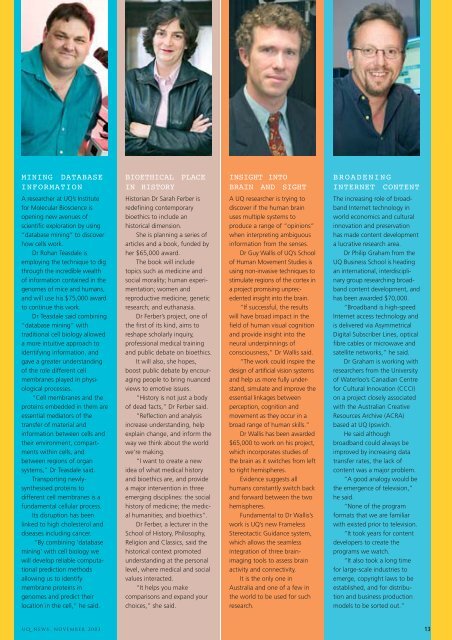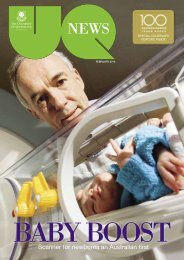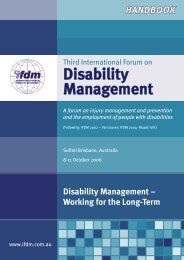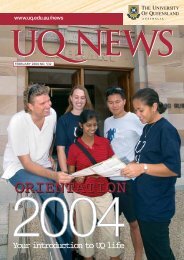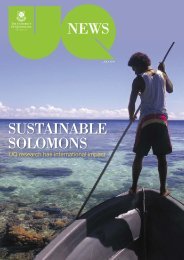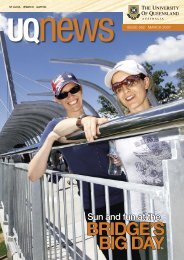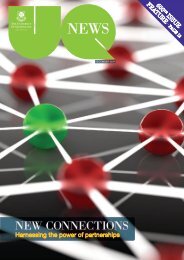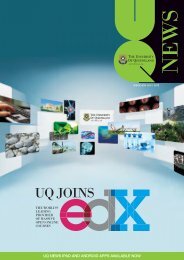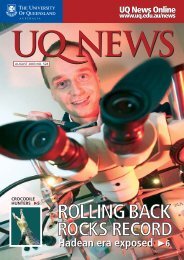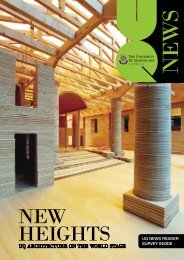01-07 cover Å - Office of Marketing and Communications - University ...
01-07 cover Å - Office of Marketing and Communications - University ...
01-07 cover Å - Office of Marketing and Communications - University ...
You also want an ePaper? Increase the reach of your titles
YUMPU automatically turns print PDFs into web optimized ePapers that Google loves.
MINING DATABASE<br />
INFORMATION<br />
A researcher at UQ’s Institute<br />
for Molecular Bioscience is<br />
opening new avenues <strong>of</strong><br />
scientific exploration by using<br />
“database mining” to dis<strong>cover</strong><br />
how cells work.<br />
Dr Rohan Teasdale is<br />
employing the technique to dig<br />
through the incredible wealth<br />
<strong>of</strong> information contained in the<br />
genomes <strong>of</strong> mice <strong>and</strong> humans,<br />
<strong>and</strong> will use his $75,000 award<br />
to continue this work.<br />
Dr Teasdale said combining<br />
“database mining” with<br />
traditional cell biology allowed<br />
a more intuitive approach to<br />
identifying information, <strong>and</strong><br />
gave a greater underst<strong>and</strong>ing<br />
<strong>of</strong> the role different cell<br />
membranes played in physiological<br />
processes.<br />
“Cell membranes <strong>and</strong> the<br />
proteins embedded in them are<br />
essential mediators <strong>of</strong> the<br />
transfer <strong>of</strong> material <strong>and</strong><br />
information between cells <strong>and</strong><br />
their environment, compartments<br />
within cells, <strong>and</strong><br />
between regions <strong>of</strong> organ<br />
systems,” Dr Teasdale said.<br />
Transporting newlysynthesised<br />
proteins to<br />
different cell membranes is a<br />
fundamental cellular process.<br />
Its disruption has been<br />
linked to high cholesterol <strong>and</strong><br />
diseases including cancer.<br />
“By combining ‘database<br />
mining’ with cell biology we<br />
will develop reliable computational<br />
prediction methods<br />
allowing us to identify<br />
membrane proteins in<br />
genomes <strong>and</strong> predict their<br />
location in the cell,” he said.<br />
BIOETHICAL PLACE<br />
IN HISTORY<br />
Historian Dr Sarah Ferber is<br />
redefining contemporary<br />
bioethics to include an<br />
historical dimension.<br />
She is planning a series <strong>of</strong><br />
articles <strong>and</strong> a book, funded by<br />
her $65,000 award.<br />
The book will include<br />
topics such as medicine <strong>and</strong><br />
social morality; human experimentation;<br />
women <strong>and</strong><br />
reproductive medicine; genetic<br />
research; <strong>and</strong> euthanasia.<br />
Dr Ferber’s project, one <strong>of</strong><br />
the first <strong>of</strong> its kind, aims to<br />
reshape scholarly inquiry,<br />
pr<strong>of</strong>essional medical training<br />
<strong>and</strong> public debate on bioethics.<br />
It will also, she hopes,<br />
boost public debate by encouraging<br />
people to bring nuanced<br />
views to emotive issues.<br />
“History is not just a body<br />
<strong>of</strong> dead facts,” Dr Ferber said.<br />
“Reflection <strong>and</strong> analysis<br />
increase underst<strong>and</strong>ing, help<br />
explain change, <strong>and</strong> inform the<br />
way we think about the world<br />
we’re making.<br />
“I want to create a new<br />
idea <strong>of</strong> what medical history<br />
<strong>and</strong> bioethics are, <strong>and</strong> provide<br />
a major intervention in three<br />
emerging disciplines: the social<br />
history <strong>of</strong> medicine; the medical<br />
humanities; <strong>and</strong> bioethics”.<br />
Dr Ferber, a lecturer in the<br />
School <strong>of</strong> History, Philosophy,<br />
Religion <strong>and</strong> Classics, said the<br />
historical context promoted<br />
underst<strong>and</strong>ing at the personal<br />
level, where medical <strong>and</strong> social<br />
values interacted.<br />
“It helps you make<br />
comparisons <strong>and</strong> exp<strong>and</strong> your<br />
choices,” she said.<br />
INSIGHT INTO<br />
BRAIN AND SIGHT<br />
A UQ researcher is trying to<br />
dis<strong>cover</strong> if the human brain<br />
uses multiple systems to<br />
produce a range <strong>of</strong> “opinions”<br />
when interpreting ambiguous<br />
information from the senses.<br />
Dr Guy Wallis <strong>of</strong> UQ’s School<br />
<strong>of</strong> Human Movement Studies is<br />
using non-invasive techniques to<br />
stimulate regions <strong>of</strong> the cortex in<br />
a project promising unprecedented<br />
insight into the brain.<br />
“If successful, the results<br />
will have broad impact in the<br />
field <strong>of</strong> human visual cognition<br />
<strong>and</strong> provide insight into the<br />
neural underpinnings <strong>of</strong><br />
consciousness,” Dr Wallis said.<br />
“The work could inspire the<br />
design <strong>of</strong> artificial vision systems<br />
<strong>and</strong> help us more fully underst<strong>and</strong>,<br />
simulate <strong>and</strong> improve the<br />
essential linkages between<br />
perception, cognition <strong>and</strong><br />
movement as they occur in a<br />
broad range <strong>of</strong> human skills.”<br />
Dr Wallis has been awarded<br />
$65,000 to work on his project,<br />
which incorporates studies <strong>of</strong><br />
the brain as it switches from left<br />
to right hemispheres.<br />
Evidence suggests all<br />
humans constantly switch back<br />
<strong>and</strong> forward between the two<br />
hemispheres.<br />
Fundamental to Dr Wallis’s<br />
work is UQ’s new Frameless<br />
Stereotactic Guidance system,<br />
which allows the seamless<br />
integration <strong>of</strong> three brainimaging<br />
tools to assess brain<br />
activity <strong>and</strong> connectivity.<br />
It is the only one in<br />
Australia <strong>and</strong> one <strong>of</strong> a few in<br />
the world to be used for such<br />
research.<br />
BROADENING<br />
INTERNET CONTENT<br />
The increasing role <strong>of</strong> broadb<strong>and</strong><br />
Internet technology in<br />
world economics <strong>and</strong> cultural<br />
innovation <strong>and</strong> preservation<br />
has made content development<br />
a lucrative research area.<br />
Dr Philip Graham from the<br />
UQ Business School is heading<br />
an international, interdisciplinary<br />
group researching broadb<strong>and</strong><br />
content development, <strong>and</strong><br />
has been awarded $70,000.<br />
“Broadb<strong>and</strong> is high-speed<br />
Internet access technology <strong>and</strong><br />
is delivered via Asymmetrical<br />
Digital Subscriber Lines, optical<br />
fibre cables or microwave <strong>and</strong><br />
satellite networks,” he said.<br />
Dr Graham is working with<br />
researchers from the <strong>University</strong><br />
<strong>of</strong> Waterloo’s Canadian Centre<br />
for Cultural Innovation (CCCI)<br />
on a project closely associated<br />
with the Australian Creative<br />
Resources Archive (ACRA)<br />
based at UQ Ipswich.<br />
He said although<br />
broadb<strong>and</strong> could always be<br />
improved by increasing data<br />
transfer rates, the lack <strong>of</strong><br />
content was a major problem.<br />
“A good analogy would be<br />
the emergence <strong>of</strong> television,”<br />
he said.<br />
“None <strong>of</strong> the program<br />
formats that we are familiar<br />
with existed prior to television.<br />
“It took years for content<br />
developers to create the<br />
programs we watch.<br />
“It also took a long time<br />
for large-scale industries to<br />
emerge, copyright laws to be<br />
established, <strong>and</strong> for distribution<br />
<strong>and</strong> business production<br />
models to be sorted out.”<br />
UQ NEWS, november 2003<br />
13


